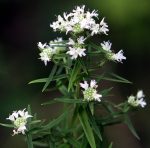 Virginia mountain mint is a herbaceous perennial native to eastern US from Maine and north Dakota, south to Georgia and Oklahoma where it grows in wet prairies, and on stream edges and moist bluffs. It is a member of the mint family, Lamiaceae, that also includes rosemary, beebalm, and ajuga. Plants grow up to 3′ tall from a rhizomateous root system and have a multi-branched green or reddish stem that are square in cross section and have hairs on the edges. The opposite linear leaves are up to 2.5″ long and are covered with a whitish bloom. From mid to late summer, terminal flat clusters appear bearing up to 50 small white tubular flowers that are 1/8″ long and are 2-lipped. The flower clusters are 3/4″ across and may be spotted with purple dots. The flowers are attractive to a variety of bees, wasps and butterflies. All parts of the plant are fragrant when crushed. The genus name, Pycnanthemm, comes from the Greek words pyknos meaning dense and anthos meaning flower and refers to the clusters of densely packed flowers. The specific epithet, virginianum, refers to the geographic location of the plant.
Virginia mountain mint is a herbaceous perennial native to eastern US from Maine and north Dakota, south to Georgia and Oklahoma where it grows in wet prairies, and on stream edges and moist bluffs. It is a member of the mint family, Lamiaceae, that also includes rosemary, beebalm, and ajuga. Plants grow up to 3′ tall from a rhizomateous root system and have a multi-branched green or reddish stem that are square in cross section and have hairs on the edges. The opposite linear leaves are up to 2.5″ long and are covered with a whitish bloom. From mid to late summer, terminal flat clusters appear bearing up to 50 small white tubular flowers that are 1/8″ long and are 2-lipped. The flower clusters are 3/4″ across and may be spotted with purple dots. The flowers are attractive to a variety of bees, wasps and butterflies. All parts of the plant are fragrant when crushed. The genus name, Pycnanthemm, comes from the Greek words pyknos meaning dense and anthos meaning flower and refers to the clusters of densely packed flowers. The specific epithet, virginianum, refers to the geographic location of the plant.
Type: Herbaceous perennial
Bloom: Flat terminal clusters of small white tubuluar 2-lipped flowers sometimes scattered with purple dots from mid to late summer
Size: 2-3′ H x 1-1.5′ W
Light: Full sun
Soil: Average, medium moist, well-drained
Hardiness: Zones 3-7
Care: Low maintenance
Pests and Diseases: None of significance; susceptible to rust
Propagation: Seed, division
Companion Plants: Stiff goldenrod, black eyed susan, sky-blue aster, New England aster, sneezeweed, joe-pye-weed
Photo Credit: Wikipedia
D